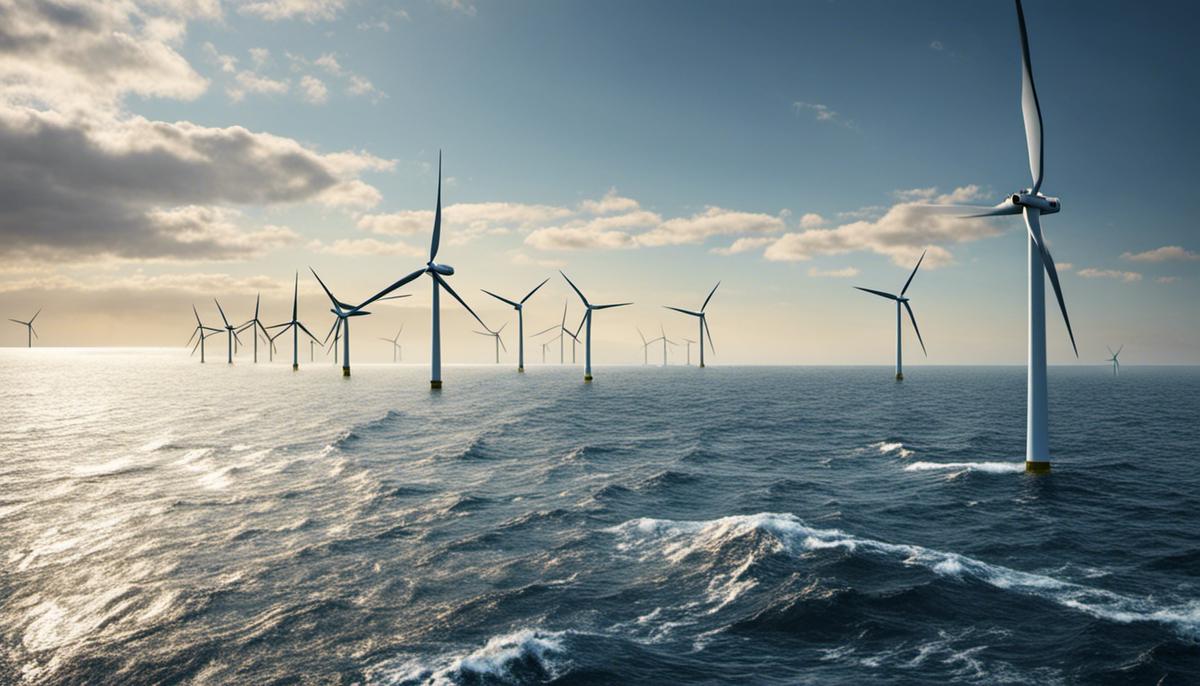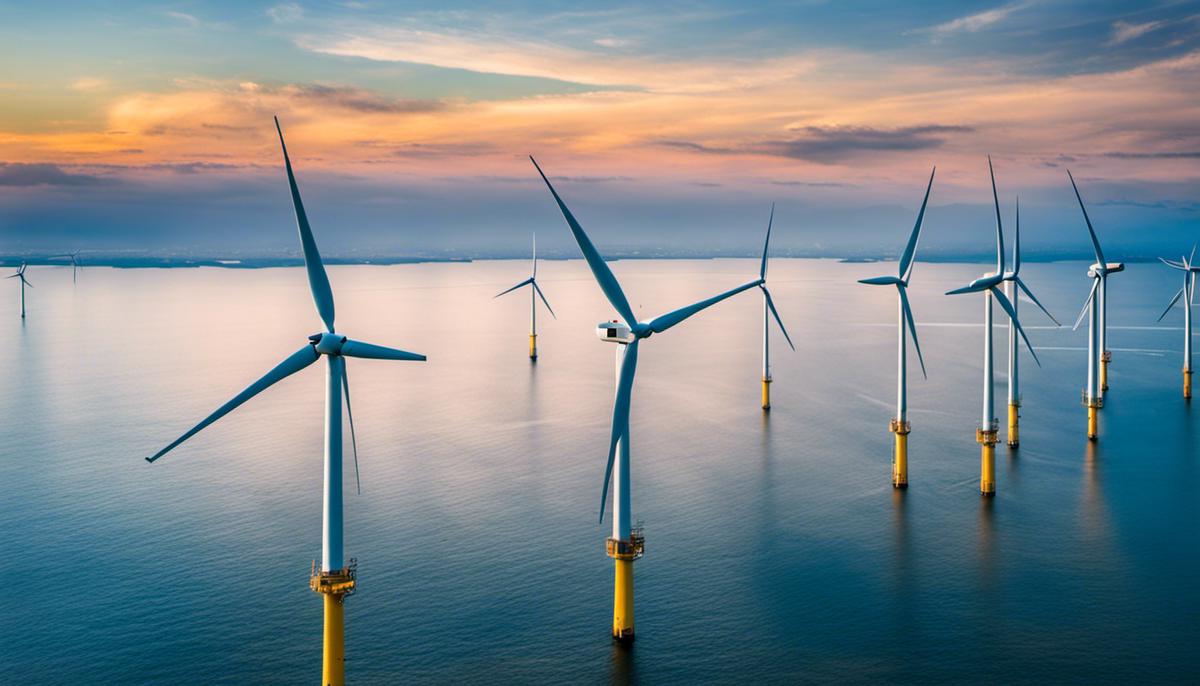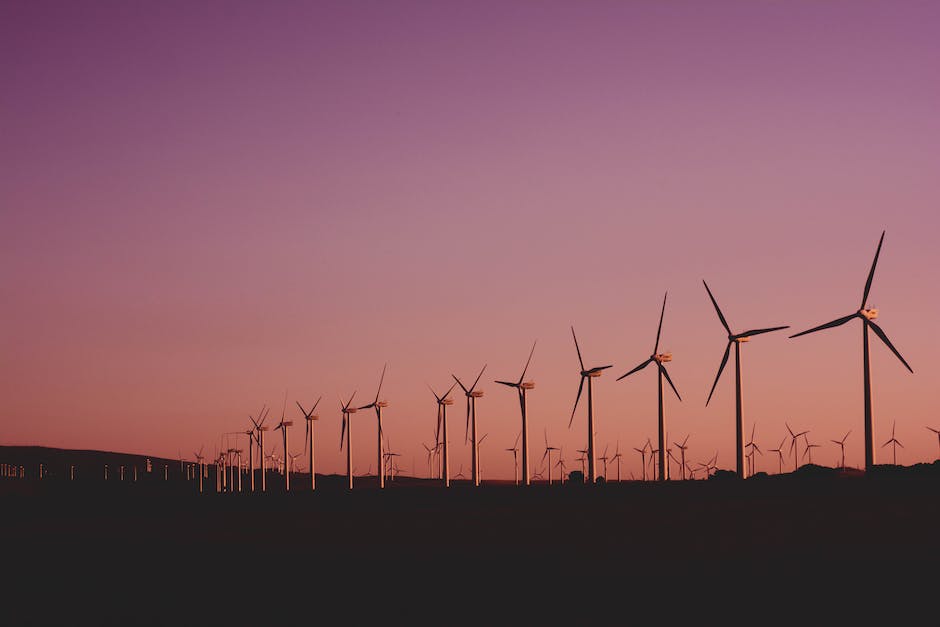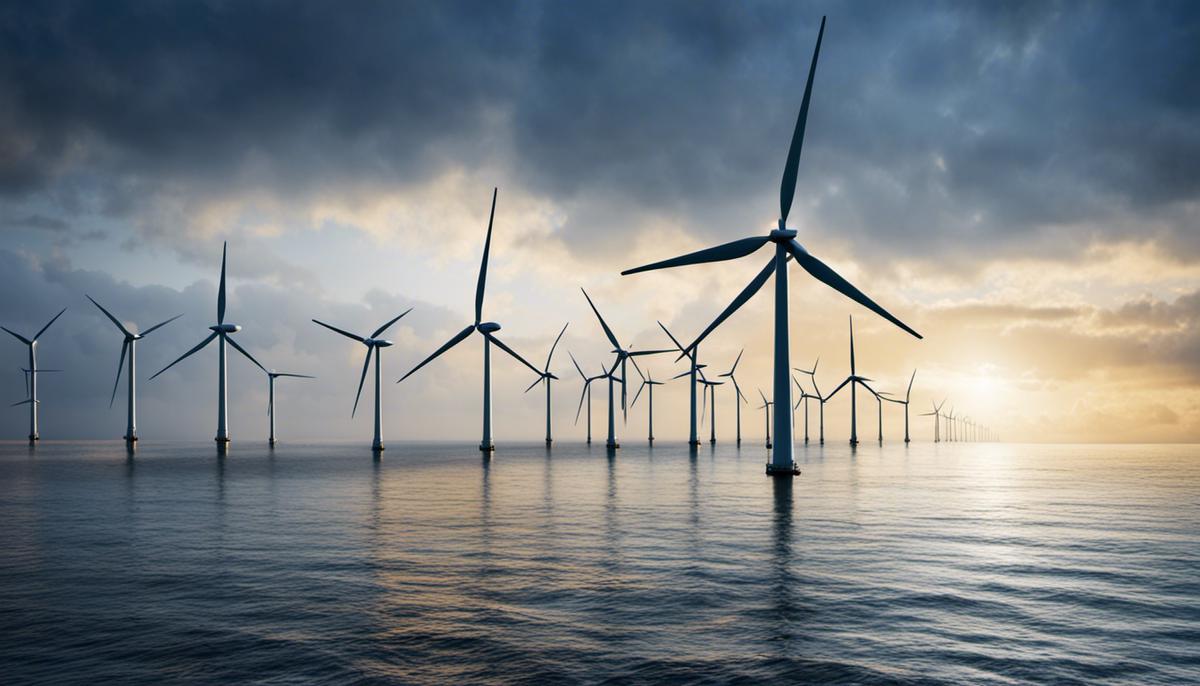Offshore Wind Journal
Overview of Offshore Wind Energy
Understanding Offshore Wind Energy
Offshore wind energy harnesses the power of the wind blowing over the oceans to generate electricity. The technology involves the installation of large wind turbines (windmills) in bodies of water, usually on the continental shelf. Actually, these turbines function like their counterpart - the onshore wind farms, but with several key differences. Offshore wind turbines, for instance, are typically larger because the challenges associated with shipping and installation are more easily overcome in a marine environment. Wind speeds are also usually higher and more consistent at sea, making offshore wind farms potentially more productive.
These wind turbines capture the kinetic energy from the wind turning their blades, which spin a rotor connected to a generator that produces electricity. This power is then transmitted through underwater cables back to land, where it is fed into the electrical grid.
Significance of Offshore Wind Energy in the Modern Energy Mix
Offshore wind energy plays a critical role in the global energy mix. As countries seek ways to reduce greenhouse gas emissions to combat climate change, renewable sources of energy like offshore wind become increasingly important. According to the International Energy Agency (IEA), offshore wind will be a $1 trillion industry by 2040, with the capacity to generate around 18 times global electricity demand.
Compared to traditional energy sources like coal and natural gas, offshore wind energy has the potential to produce large amounts of electricity without releasing emissions. Offshore wind farms also don't need water for cooling, making them a sustainable source of power in areas where water resources are scarce.
Advantages of Offshore Wind Energy
One of the most significant benefits of offshore wind energy is its potential to deliver clean, renewable power. Unlike fossil fuels, wind is a virtually inexhaustible resource that doesn't produce harmful emissions. As a renewable source of power, wind energy could play a significant role in meeting global renewables targets and reducing the impact of climate change.
In addition to environmental benefits, offshore wind energy can provide significant economic advantages. Construction, operation, and maintenance of offshore wind farms create numerous jobs, aiding in economic growth. According to the U.S. Department of Energy, the offshore wind industry could support over 600,000 jobs by 2050.
On a local scale, offshore wind farms can also contribute to energy security by providing a domestic source of power. Given the global push to diversify energy resources, offshore wind energy seems poised to become a significant part of many countries' energy strategies.
Spotlight on Significant Offshore Wind Projects Worldwide
Offshore wind energy has been making waves in the global renewable energy scene. The Hornsea One in the United Kingdom stands as the largest offshore wind farm across the globe. Situated off Yorkshire's coast, this robust renewable asset can produce up to 1.2 GW of electricity.
On American soil, the Vineyard Wind project earmarked off Massachusetts is set to become the first full-scale offshore wind farm in the country. It's projected to generate a massive amount of electricity sufficient to power over 400,000 homes.
China, a dominant player in Asia, boasts several expansive offshore wind projects, notably the Guangdong Yudean Yangjiang Nanpeng Island Offshore Wind Farm, yielding a 400 MW capacity. It's part of the country's blueprint to amplify its offshore wind capacity in its quest for carbon neutrality by 2060.
These substantial offshore wind projects underscore the escalating influence of this renewable energy source worldwide and its immense potential in carving out a greener, more sustainable future.

Top Offshore Wind Projects Around the Globe
More on Hornsea Project One, UK
Heading the list of world's largest offshore wind farms is the Hornsea Project One, based out of the United Kingdom. Becoming fully operational in 2020, it commands a massive capacity of 1.2 Gigawatts. Leading this pioneering project is Danish energy company Ørsted, utilizing Siemens Gamesa turbines. The wind farm sprawls over a space equivalent to about 407 square kilometers, stationed nearly 120 kilometers away from Yorkshire's shoreline.
Walney Extension, United Kingdom
Operational since 2018, the Walney Extension wind project is another large offshore wind project located in the United Kingdom. This project offers a substantial capacity of 659 Megawatts. Danish power company Ørsted again leads the project, with turbines supplied by both MHI Vestas and Siemens Gamesa. The wind farm resides in the Irish Sea, off the Walney Island coast in Cumbria.
Yangjiang Nanpeng Island, China
China's largest offshore wind farm, Yangjiang Nanpeng Island, became operational in 2019 and holds a capacity of 400 Megawatts. The Chinese state-owned utility company, China General Nuclear Power, controls this project. The wind project is located 90 kilometers off the coast of Guangdong. It employs turbines supplied by Ming Yang Smart Energy.
Borssele 1 & 2, Netherlands
Operational since 2020, Borssele 1 and 2 is located 22 kilometers off the coast of the Zeeland province in the Netherlands. The capacity of this offshore wind farm is 752 Megawatts. The Danish energy company Ørsted is managing this project as well, leveraging Siemens Gamesa turbines.
Greater Gabbard, United Kingdom
One more significant wind project in the United Kingdom, the Greater Gabbard, has been in operation since 2012. The project generates a capacity of 504 Megawatts. The multi-national utilities conglomerate ScottishPower Renewables and Swedish energy company Vattenfall co-own this offshore wind farm. Fluor Corporation was responsible for assembly and installation, and the project employs turbines by Siemens. The project is located 23 kilometers off the Suffolk coast.
Gemini Offshore Wind Park, Netherlands
In the North Sea, 85 miles from the Dutch coast, the Gemini Offshore Wind Park boasts a capacity of 600 Megawatts. It's been making strides since 2017 and ranks as one of the world's largest wind farms. The crucial stakeholders for this project are the Canadian utility company Northland Power, wind turbine maker Siemens, waste processing company HVC, and Dutch maritime contractor Van Oord.
Baltics's Powerhouse: Arkona Offshore Wind Farm, Germany
Making a grand leap into the energy efficient sector, Germany anchored the Arkona Offshore Wind Farm in the Baltic Sea and powered it up in 2019. This mammoth project boasts of a hefty 385 Megawatt capacity, lighting up thousands of households. Churning out this magnitude of energy are the top-notch turbines from Siemens Gamesa. But none of this would have been possible without the joint venture of two major powerhouses: Germany's electric utilities company E.ON and Norway's esteemed energy company Equinor.

Challenges and Solutions in Offshore Wind Energy
Offshore Wind Energy Projects: The Uphill Challenges
Embarking upon the venture of offshore wind energy projects isn't for the faint-hearted. One of the steepest barriers to entry happens to be financial. Offshore projects invariably scale higher on the cost spectrum compared to their onshore counterparts, primarily due to the amplified risk profile and complex operations inherent to the offshore environment. From transporting equipment, getting them into place, to their maintenance and operations, the costs can be daunting and act as a deterrent for the proliferation of this potent renewable energy source.
And that's not all; offshore wind projects also find themselves entangled in a complex web of regulatory conundrums. These range from local to international levels, encompassing not just national laws but also maritime ones, often putting the project's feasibility and profitability at stake.
Ecological Challenges in Offshore Wind Energy Projects
Ecological challenges also pose a significant hurdle to the development of offshore wind projects. These developments can potentially impact marine wildlife and their habitats, leading to their displacement or even death. Bird and bat deaths due to turbine collisions are a significant concern. Additionally, the noise and vibration produced by the wind turbines can have detrimental effects on marine species, disrupting their feeding, breeding, and migration patterns.
Logistical Challenges in Offshore Wind Energy Projects
In terms of logistics, the remote location and hostile environment of offshore wind projects impose a series of challenges. Workers' safety and welfare are always a paramount concern since harsh weather conditions can often make working offshore very dangerous. Furthermore, transporting the enormous turbines and other components over long distances across the sea is a complex and costly operation requiring specialized ships and equipment.
Emerging Solutions to Overcome Challenges in Offshore Wind Energy Projects
Many innovative solutions are coming to the forefront to address the obstacles associated with offshore wind energy projects, increasing both their feasibility and cost-effectiveness. The advent of larger and more productive turbines is steadily decreasing costs, while floating wind turbines present a solution to expand viable sites for offshore wind projects, helping to alleviate some environmental and logistical difficulties.
Furthermore, persistent research and development efforts are creating methods to limit the environmental impacts. These require extensive wildlife surveys prior to construction and the utilization of radar and thermal imaging to monitor avian and bat activities. Noise reduction technologies are also under research and development.
In relation to regulatory hurdles, a collaborative approach involving developers, regulators, and other stakeholders can resolve potential conflicts and set the stage for successful project execution. Open, constructive communication is key to fostering an environment conducive to project development.
In summary, although offshore wind energy projects come with their unique set of challenges, continuous progress in technology, regulation, and environmental conservation is making these projects increasingly feasible and eco-friendly. Holistic problem-solving approaches that consider all aspects can lead the way for the extensive use of offshore wind as a major worldwide renewable energy source.

Future of Offshore Wind Energy
A Glimpse into the Future of Offshore Wind Energy
Offshore wind energy is rapidly emerging as a leading form of renewable energy. It harnesses the power of sea winds to generate electricity, which can then be transferred to power grids via undersea cables. Thanks to technological advancements and forward-thinking government policies, the offshore wind sector is predicted to surge in growth over the next few years.
Innovative Technologies in the Pipeline
One major breakthrough in the pipeline is the development of larger and more efficient wind turbines. Companies such as General Electric have already tested prototypes of such massive turbines, capable of generating 12 MW of power, enough to power 16,000 homes. Another innovative technology to watch is floating wind farms. Unlike conventional wind farms that are anchored to the seabed, floating wind farms are stabilised on the water surface. This mechanism allows them to be deployed in deeper waters, and subsequently harness stronger winds.
Wind energy storage technology is also improving, allowing excess energy produced to be stored and used when wind speeds are low. Spin-off technologies like wind-hydro systems, where excess energy is used to pump water to an upper reservoir for later use, and battery technologies are examples in this category.
Predicted Growth of the Offshore Wind Sector
According to research by The Global Wind Energy Council, offshore wind capacity could reach 234 GW by 2030, reflecting a significant increase from the 29.1 GW recorded at the end of 2019. This growth is largely driven by the declining cost of technology and strong policy support. Areas like Europe and East Asia are set to remain leaders in the industry, but newer markets in regions like the U.S, South America, and Africa are expected to contribute significantly to this growth.
Potential Impact on Global Renewable Energy Infrastructure
The expansion of offshore wind energy is set to have a profound impact on the global renewable energy infrastructure. It will provide stable, clean power to coastal and island communities, reducing their reliance on imported fossil fuels. On a larger scale, offshore wind energy can substantially contribute to such nations' power grids, reducing energy costs and cutting down greenhouse gas emissions.
Furthermore, as offshore wind technology becomes more prevalent, it could also spur an increase in green jobs and economic growth. For instance, powering the entire United States with offshore wind energy would require building about 4,000 turbines each year from 2020 to 2035, which could potentially create thousands of jobs in construction, installation, and maintenance.
Finally, these projects' offshore positioning will ensure they do not compete with residential or commercial land use, hence veering away from controversies of where wind turbines should be sited on land.
Overall, the future of offshore wind energy promises great potential, with myriad benefits that resonate well with our quest for a clean, affordable, and sustainable energy future.

Offshore wind energy stands at the precipice of monumental developments that have the potential to redefine our world's energy landscape. The promising advancements and innovative technologies in the pipeline are poised to propel this sector onto even greater heights. As we look forward to the future of offshore wind energy and the growth of the renewable energy sector, it's clear that these are not merely hopeful speculations, but tangible realities that will significantly contribute to the global renewable energy infrastructure. The challenges that lie ahead are not inconsiderable, but with sustained efforts and dedication, our race towards a more sustainable and healthier planet is truly within our grasp.
